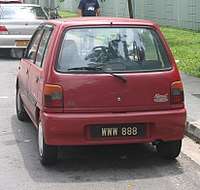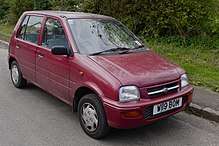Perodua Kancil
| Perodua Kancil | |
|---|---|
_(front)%2C_Kuala_Lumpur.jpg) | |
| Overview | |
| Manufacturer | Perodua |
| Also called |
Perodua Nippa (United Kingdom) Daihatsu Ceria (Indonesia) |
| Production |
1994–2009 722,223 built |
| Body and chassis | |
| Class |
Kei car City car |
| Body style | 5-door hatchback |
| Layout | FF layout |
| Related | Daihatsu Mira (3rd generation) |
| Powertrain | |
| Engine |
659 cc Daihatsu EF-CL SOHC I3 849 cc Daihatsu ED-10 SOHC I3 849 cc Daihatsu ED-DE DOHC I3 |
| Transmission |
4-speed manual 5-speed manual 3-speed automatic |
| Dimensions | |
| Wheelbase | 2,280 mm (89.8 in) |
| Length | 3,395 mm (133.7 in) |
| Width | 1,405 mm (55.3 in) |
| Height | 1,415 mm (55.7 in) |
| Curb weight | 650–690 kg (1,430–1,520 lb) |
| Chronology | |
| Successor | Perodua Kelisa |
The Perodua Kancil (also known as the Perodua Nippa in the United Kingdom, and Daihatsu Ceria in Indonesia) is a city car manufactured by Malaysian automobile manufacturer Perodua from August 1994 to 2009.[1] The Kancil is a rebadged third generation Daihatsu Mira.
History
_(front)%2C_Kuala_Lumpur.jpg)

_(front)%2C_Kuala_Lumpur.jpg)
_(rear)%2C_Kuala_Lumpur.jpg)
_(front)%2C_Serdang.jpg)
_(rear)%2C_Serdang.jpg)
_(front)%2C_Seri_Kembangan.jpg)
_(rear)%2C_Seri_Kembangan.jpg)
The Kancil was Perodua's first car after its founding in 1992.[1] It is a small five-door hatchback vehicle on a monocoque framework that can seat five people. The Kancil, like its predecessors, is a slightly modified Daihatsu Mira L200; rebadging is common in Malaysia's automotive industry, having begun in 1985 with car maker Proton, which based its cars on retired models of Mitsubishi Motors. Subsequent Kancils were only rejuvenated cosmetically as Perodua maintained the monocoque structure and tweaked its engines.
The Kancil is named after the mouse deer (chevrotain) native to Malaysia. The car was available with two engines, a 660 cc version with 31 PS (23 kW) and an 850 with 37 PS (27 kW). Four- or five-speed manual transmissions were available (four-speed was not available in the 850) or a three-speed automatic.[2]
In January 1995, the Perodua Kancil EZ was launched. It came with an automatic transmission and in addition to the existing equipment on the GX variant, there was colored bumpers, gear lock, side protector molding, hazard sign and the first-aid kit for metallic and mica models only. It was launched at RM28,931.14 for the solid colors (Kristal White and Bunga Raya Red), RM 29,838.14 for the Metallic version (Kilauan Silver) and RM 30,214.00 for the Mica version (Blue Mica) in Peninsular Malaysia.[3]
On 27 August 1997, the Perodua Kancil was facelifted. Changes included new design for the larger front grille, rear garnish, rounded indicator lights and different wheel caps designs, new cabin upholstery with the use of improved seat fabric and 2 front washer nozzles. The Kancil 850 cc series, got new white faced metres and adjustable head rest. Prices were between RM 24,833.74 to RM 33,465.84.[4]
On 3 May 1998, the Perodua Kancil EX extra was launched. It came with a 660cc engine and 5-speed manual transmission.[5]
In 2000, the car was given another slight facelift consisting of body-coloured side mouldings, a new grille and reprofiled front bumper with larger indicators.
The Kancil received a more extensive restyling in September 2002,[1] featuring rounder headlights, taillights and bumpers; its rear license plate was also repositioned onto its hatch from the bumper below. Its interior features a flushed dashboard with the combination instrumentation panel placed in the middle similar to that of the Toyota Yaris. However, it is still mechanically identical to its predecessor, except for the EZi automatic transmission variant which was given a fuel-injected powerplant though this variant wasn't available at launch. Perodua cited Daihatsu’s thorough testing procedures and the engine being made locally with many local component for the EZi variant to be only introduced later on. At launch only manual transmission equipped variants were available: 660EX and 850EX.[6]
In February 2003, the Perodua Kancil EZi was launched. It came with an automatic transmission and an electronic fuel injected engine.[7]
From July 2005 a tuned Kancil SE version was also available.[8]
Production of Kancil ceased on 20 July 2009 and replaced by the basic model of Perodua Viva known as Perodua Viva 660BX which comes in manual transmission only.[9]
Models
The Kancil was sold in three variants:
- Kancil 660EX- 659 cc three-cylinder carbureted in-line engine, 31 PS (23 kW), five-speed manual transmission, black bumpers and door rub strips.
- Kancil 850EX, EZ- 847 cc three-cylinder carbureted in-line engine, 37 PS (27 kW), five-speed manual transmission and three-speed automatic transmission, body-color bumpers and rub strips.
- Kancil 850EZi- 847 cc three-cylinder fuel-injected in-line engine, 49 hp (37 kW), three-speed automatic transmission, body color bumpers and rub strips.
Sales
Following its release in 1994, the Kancil became an instant success in Malaysia. The Kancil is popular with beginner drivers and is commonly used in Malaysian driving schools. It was also preferable for its fuel efficiency and ease of parking due to its size. In December 1995, Perodua produced its 50,000th Kancil. By January 1997, 100,000 Kancils had been manufactured, and by 1999 250,000 had been built. Average monthly production during its fifteen years was 4,000, with October 2002 being the most successful month with 7,700 built.[10] In total 722,223 Kancils were built, of which around 14,000 were exported.[10]
Export

United Kingdom
The Perodua Kancil was sold in the United Kingdom as the Perodua Nippa in September 1997. It was priced at just over £5,000 (cut to £4,999 in 1999) it was the cheapest new car on sale there until it was replaced by the Perodua Kelisa four years later.[11]
.jpg)
Indonesia
In Indonesia, the Perodua Kancil was sold as the Daihatsu Ceria. The Ceria, meaning "happy" or "cheerful" in Malay/Indonesian, was introduced at the 11th Gaikindo Auto Expo in Jakarta in July 2001.[12] It had been preceded the year before by the Daihatsu KX-P "concept car" - a standard Kancil equipped with a leather and wood interior.[13] The Ceria was only available with the larger 850 cc engine with a carburettor and 37 PS (27 kW), in two equipment levels: the base model KL and the more extra-spec KX, which received a chromed grille.[14] It was discontinued in 2006. It was later superseded in 2014 by a spiritual successor, the Ayla, which is also rebadged as the Toyota Agya.
References
- 1 2 3 World of Cars 2006·2007. Warsaw, Poland: Media Connection Sp. z o.o. 2006. p. 203.
- ↑ Hasrine, Eddie. "Kancil Specifications". Mira/Kancil Turbo Site. Retrieved 2013-01-13.
- ↑ "Perodua.com :: News & Events :: 1995". 2004-06-11. Archived from the original on 2004-06-11. Retrieved 2017-09-03.
- ↑ "Perodua.com :: News & Events :: 1997". 2003-12-26. Archived from the original on 2003-12-26. Retrieved 2017-09-03.
- ↑ "Perodua.com.my :: News & Events :: 1998". 2004-02-20. Archived from the original on 2004-02-20. Retrieved 2017-09-03.
- ↑ 3348 (2002-09-28). "The New Perodua Kancil – UPDATED STORY - Autoworld.com.my". Autoworld.com.my. Retrieved 2018-08-26.
- ↑ "Perodua.com.my :: News & Events :: 2003". 2004-02-20. Archived from the original on 2004-02-20. Retrieved 2017-09-03.
- ↑ World of Cars 2006·2007. Warsaw, Poland: Media Connection Sp. z o.o. 2006. p. 203.
- ↑ "Perodua Viva 660 BX replaces the Kancil". Paul Tan's Automotive News. 2009-07-20. Retrieved 2018-08-26.
- 1 2 Mahalingam, Eugene (2009-07-21). "Perodua on track to achieve 2009 sales target". The Star. Malaysia: Star Publications (M) Bhd. Retrieved 2013-01-13.
- ↑ Enright, Andy (2004-08-04). "Perodua Nippa (1997-2001): Malaysian Invasion". Yahoo! Cars. Yahoo! Inc.
- ↑ Harsanto, Damar (2001-07-21). "Auto expo goes ahead despite political showdown". Jakarta Post. Jakarta, Indonesia: PT. Bina Media Tenggara: 3. Archived from the original on 2016-03-05. Retrieved 2013-01-13.
- ↑ "Press Information: KX-P" (PDF). Astra Daihatsu Motor. 2000. Archived from the original (PDF) on 2009-10-14. Retrieved 2013-01-13.
- ↑ "Press Information: Ceria" (PDF). Astra Daihatsu Motor. 2001. p. 3. Archived from the original (PDF) on 2010-07-28. Retrieved 2013-01-13.
External links
| Wikimedia Commons has media related to Perodua Kancil. |
| Wikimedia Commons has media related to Daihatsu Ceria. |
Perodua road vehicle timeline, 1994–present | |||||||||||||||||||||||||||||
|---|---|---|---|---|---|---|---|---|---|---|---|---|---|---|---|---|---|---|---|---|---|---|---|---|---|---|---|---|---|
| Type | 1990s | 2000s | 2010s | ||||||||||||||||||||||||||
| 4 | 5 | 6 | 7 | 8 | 9 | 0 | 1 | 2 | 3 | 4 | 5 | 6 | 7 | 8 | 9 | 0 | 1 | 2 | 3 | 4 | 5 | 6 | 7 | 8 | |||||
| Kei car | Kancil | ||||||||||||||||||||||||||||
| City car | Kelisa | Viva | Axia | ||||||||||||||||||||||||||
| Bezza | |||||||||||||||||||||||||||||
| Supermini | Myvi | Myvi | Myvi | ||||||||||||||||||||||||||
| Mini SUV | Kembara | Nautica | |||||||||||||||||||||||||||
| Mini MPV | Kenari | ||||||||||||||||||||||||||||
| Compact MPV | Alza | ||||||||||||||||||||||||||||
| Microvan | Rusa | ||||||||||||||||||||||||||||
« previous — Daihatsu road vehicle timeline, 1990s–present | ||||||||||||||||||||||||||||||||||||
|---|---|---|---|---|---|---|---|---|---|---|---|---|---|---|---|---|---|---|---|---|---|---|---|---|---|---|---|---|---|---|---|---|---|---|---|---|
| Type | 1990s | 2000s | 2010s | |||||||||||||||||||||||||||||||||
| 0 | 1 | 2 | 3 | 4 | 5 | 6 | 7 | 8 | 9 | 0 | 1 | 2 | 3 | 4 | 5 | 6 | 7 | 8 | 9 | 0 | 1 | 2 | 3 | 4 | 5 | 6 | ||||||||||
| Kei car | Mira/Cuore | Mira/Cuore | Mira/Cuore | Mira/Cuore | Mira/Cuore/Charade | |||||||||||||||||||||||||||||||
| Naked | Esse | Mira e:S | ||||||||||||||||||||||||||||||||||
| Leeza | Mira Gino | Mira Gino/Trevis | Mira Cocoa | |||||||||||||||||||||||||||||||||
| Opti | Opti | Tanto Exe | ||||||||||||||||||||||||||||||||||
| Move | Move | Move | Move | Move | ||||||||||||||||||||||||||||||||
| MAX | Sonica | |||||||||||||||||||||||||||||||||||
| Tanto | Tanto | |||||||||||||||||||||||||||||||||||
| Wake | ||||||||||||||||||||||||||||||||||||
| Subcompact car | Mira Gino 1000 | Ayla | ||||||||||||||||||||||||||||||||||
| Charade | Charade | Ceria | Charade | |||||||||||||||||||||||||||||||||
| Storia/Sirion | Boon/Sirion | Boon/Sirion | Boon | |||||||||||||||||||||||||||||||||
| Compact car | Applause | |||||||||||||||||||||||||||||||||||
| Mid-size car | Altis | Altis | Altis | Altis | ||||||||||||||||||||||||||||||||
| Sports car | Leeza Spider | Copen | Copen | |||||||||||||||||||||||||||||||||
| Mini MPV | YRV | Coo/Materia | ||||||||||||||||||||||||||||||||||
| Boon Luminas | Sigra | |||||||||||||||||||||||||||||||||||
| Pyzar/Gran Move | Pyzar/Gran Move | Xenia | Xenia | |||||||||||||||||||||||||||||||||
| Mini SUV | Rocky/Feroza/Sportrak | Rocky/Feroza/Sportrak | ||||||||||||||||||||||||||||||||||
| Terios/Taruna | Be-go/Terios | |||||||||||||||||||||||||||||||||||
| Terios Kid | ||||||||||||||||||||||||||||||||||||
| Compact SUV | Rugger/Fourtrak/Taft | Rugger/Fourtrak | ||||||||||||||||||||||||||||||||||
| Kei truck/Microvan | Hijet | Hijet | Hijet | Hijet | ||||||||||||||||||||||||||||||||
| Midget II | ||||||||||||||||||||||||||||||||||||
| MUV/Light commercial vehicle | Delta Van | Delta Van | Zebra | |||||||||||||||||||||||||||||||||
| Delta | Delta | Delta | ||||||||||||||||||||||||||||||||||
| Atrai 7 | ||||||||||||||||||||||||||||||||||||
| Hijet Gran Cargo/Extol | Gran Max | |||||||||||||||||||||||||||||||||||
| Luxio | ||||||||||||||||||||||||||||||||||||